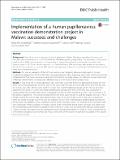Files in this item
Implementation of a human papillomavirus vaccination demonstration project in Malawi : successes and challenges
Item metadata
| dc.contributor.author | Msyamboza, Kelias Phiri | |
| dc.contributor.author | Mwagomba, Beatrice Matanje | |
| dc.contributor.author | Valle, Moussa | |
| dc.contributor.author | Chiumia, Hastings | |
| dc.contributor.author | Phiri, Twambilire | |
| dc.date.accessioned | 2017-06-27T10:30:16Z | |
| dc.date.available | 2017-06-27T10:30:16Z | |
| dc.date.issued | 2017-06-26 | |
| dc.identifier | 250348981 | |
| dc.identifier | 86f5d054-5870-4e76-96da-78d974a5b014 | |
| dc.identifier | 85021256510 | |
| dc.identifier | 000404299600004 | |
| dc.identifier.citation | Msyamboza , K P , Mwagomba , B M , Valle , M , Chiumia , H & Phiri , T 2017 , ' Implementation of a human papillomavirus vaccination demonstration project in Malawi : successes and challenges ' , BMC Public Health , vol. 17 , no. 1 , 599 . https://doi.org/10.1186/s12889-017-4526-y | en |
| dc.identifier.issn | 1471-2458 | |
| dc.identifier.other | RIS: Msyamboza2017 | |
| dc.identifier.uri | https://hdl.handle.net/10023/11093 | |
| dc.description.abstract | Background: Cervical cancer is a major public health problem in Malawi. The age-standardized incidence and mortality rates are estimated to be 75.9 and 49.8 per 100,000 population, respectively. The availability of the human papillomavirus (HPV) vaccine presents an opportunity to reduce the morbidity and mortality associated with cervical cancer. In 2013, the country introduced a school-class-based HPV vaccination pilot project in two districts. The aim of this study was to evaluate HPV vaccine coverage, lessons learnt and challenges identified during the first three years of implementation. Methods: This was an evaluation of the HPV vaccination project targeting adolescent girls aged 9–13 years conducted in Malawi from 2013 to 2016. We analysed programme data, supportive supervision reports and minutes of National HPV Task Force meetings to determine HPV vaccine coverage, reasons for partial or no vaccination and challenges. Administrative coverage was validated using a community-based coverage survey. Results: A total of 26,766 in-school adolescent girls were fully vaccinated in the two pilot districts during the first three years of the programme. Of these; 2051 (7.7%) were under the age of 9 years, 884 (3.3%) were over the age of 13 years, and 23,831 (89.0%) were aged 9–13 years (the recommended age group). Of the 765 out-of-school adolescent girls aged 9–13 who were identified during the period, only 403 (52.7%) were fully vaccinated. In Zomba district, the coverage rates of fully vaccinated were 84.7%, 87.6% and 83.3% in year 1, year 2 and year 3 of the project, respectively. The overall coverage for the first three years was 82.7%, and the dropout rate was 7.7%. In Rumphi district, the rates of fully vaccinated coverage were 90.2% and 96.2% in year 1 and year 2, respectively, while the overall coverage was 91.3%, and the dropout rate was 4.9%. Administrative (facility-based) coverage for the first year was validated using a community-based cluster coverage survey. The majority of the coverage results were statistically similar, except for in Rumphi district, where community-based 3-dose coverage was higher than the corresponding administrative-coverage (94.2% vs 90.2%, p < 0.05), and overall (in both districts), facility-based 1-dose coverage was higher than the corresponding community-based (94.6% vs 92.6%, p < 0.05). Transferring out of the district, dropping out of school and refusal were some of the reasons for partial or no uptake of the vaccine. Conclusion: In Malawi, the implementation of a school-class-based HPV vaccination strategy was feasible and produced high (>80%) coverage. However, this strategy may be associated with the vaccination of under- and over-aged adolescent girls who are outside of the vaccine manufacturer’s stipulated age group (9–13 years). The health facility-based coverage for out-of-school adolescent girls produced low coverage, with only half of the target population being fully vaccinated. These findings highlight the need to assess the immunogenicity associated with the administration of a two-dose schedule to adolescent girls younger or older than 9–13 years and effectiveness of health facility-based strategy before rolling out the programme. | |
| dc.format.extent | 7 | |
| dc.format.extent | 365872 | |
| dc.language.iso | eng | |
| dc.relation.ispartof | BMC Public Health | en |
| dc.subject | Cervical cancer | en |
| dc.subject | Human papilloma virus | en |
| dc.subject | HPV vaccination | en |
| dc.subject | Sub-Saharan Africa | en |
| dc.subject | Malawi | en |
| dc.subject | RC0254 Neoplasms. Tumors. Oncology (including Cancer) | en |
| dc.subject | RA0421 Public health. Hygiene. Preventive Medicine | en |
| dc.subject | NDAS | en |
| dc.subject | SDG 3 - Good Health and Well-being | en |
| dc.subject.lcc | RC0254 | en |
| dc.subject.lcc | RA0421 | en |
| dc.title | Implementation of a human papillomavirus vaccination demonstration project in Malawi : successes and challenges | en |
| dc.type | Journal article | en |
| dc.contributor.institution | University of St Andrews. School of Medicine | en |
| dc.identifier.doi | 10.1186/s12889-017-4526-y | |
| dc.description.status | Peer reviewed | en |
This item appears in the following Collection(s)
Items in the St Andrews Research Repository are protected by copyright, with all rights reserved, unless otherwise indicated.

